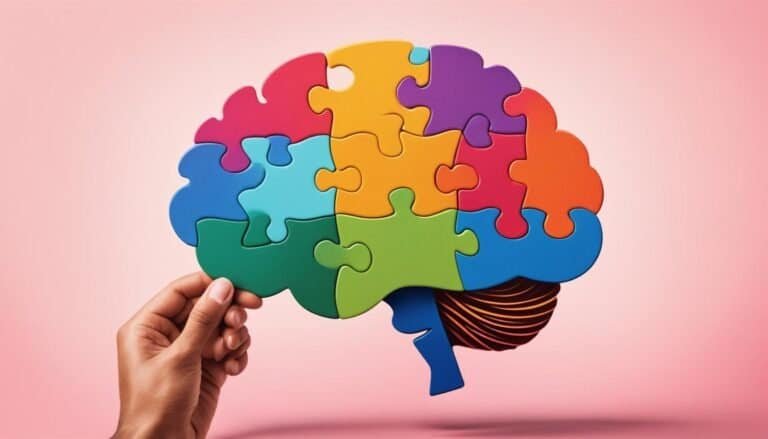Understanding The Serial Position Effect in Memory
Have you ever noticed how we often forget the middle of a list but remember the first and last easily? This is called The Serial Position Effect. It’s key to how we remember things. In cognitive psychology, it shows how our brains handle information. It also helps us in many areas, like education and marketing.
Knowing about list retention can make us better at remembering and using information. This is really important for learning and remembering things.
Key Takeaways
- The Serial Position Effect shows we remember the start and end of a list better than the middle.
- The Primacy Effect helps us remember the first items, and the Recency Effect helps us remember the last ones.
- Studies by Hermann Ebbinghaus first showed us the Serial Position Effect through experiments.
- This effect is used in design and marketing to help us remember things better.
- Research shows the Serial Position Effect uses both long-term and short-term memory in tasks.
What is the Serial Position Effect?
The Serial Position Effect is a key finding in cognitive psychology. It shows how we remember items based on where they are in a list. We tend to remember the first and last items better, but the middle ones less.
This effect helps us understand how our memory works. It shows how our brains organize and process information.
Definition
When we see a list of items, how well we remember them depends on their position. The first items (primacy effect) and the last items (recency effect) are easier to recall. This shows a clear pattern in how we remember information.
Imagine you’re asked to remember a list of words. You might remember about:
| Word Position | Recall Rate |
|---|---|
| First Three Words | 70% |
| Last Three Words | 60% |
| Middle Three Words | 40% |
This shows how important the position of items is when we process information. The Serial Position Effect impacts learning and memory in many areas. It’s crucial in education and other fields.
How the Serial Position Effect Works
The Serial Position Effect shows how we remember items based on where they are in a list. It has two main parts: the primacy effect and the recency effect. The primacy effect says that items at the start of a list stick in our memory better. This is because they get more chances to be rehearsed in our minds.
This rehearsal helps encode these items deeply into our long-term memory. On the other hand, the recency effect tells us that the last items in a list are also easier to remember. These items stay in short-term memory, making them quicker to recall.
These effects give us clues about how our brains work when processing information. They help us understand how to improve memory and recall strategies. By knowing these, we can make information easier to remember in different situations.
For example, marketers use these effects to make ads more memorable. They put catchy phrases or images at the start or end to keep viewers interested. Website designers also use this knowledge to place key information where it’s easy to find. This way, users can quickly remember important details.
Using these strategies helps us remember better in learning and making decisions. It’s all about making information stick in our minds.
The Primacy Effect Explained
The primacy effect is key to how we remember things. It’s when we remember items at the start of a list better than those at the end. This effect uses long-term memory and happens because we get to rehearse the first items more.
Understanding the Primacy Effect
Studies show the primacy effect is important for remembering things. For example, research by Murdock found that we remember the first items in a list much better than the later ones. The timing of when we see and recall information affects this effect a lot.
Other studies, like those by Glanzer and Cunitz, showed that rehearsing information is crucial for remembering it. If we don’t rehearse, we might forget both the first and last items. This shows that our memory has two parts, and the first part is key for remembering the start of a list.
The primacy effect is useful in many areas, not just school. Companies use it in ads to make a strong first impression. It also helps us make better choices when looking at many options.
| Study | Finding | Implication |
|---|---|---|
| Murdock | Better recall of initial items | Highlights long-term memory role in memory recall |
| Glanzer & Cunitz | Rehearsal essential for memory retention | Supports dual memory systems concept |
| Asch | Order impacts ratings | Demonstrates influence of primacy in social judgments |
| Murdoch | Length influences recall probability | Initial items remembered better under varying list lengths |
As we learn more about how our brains work, the primacy effect stays important. It helps us understand how to remember and make decisions better. It shows how our brains process information in complex ways.
The Recency Effect Explained
The recency effect is key in how we remember things, especially the last items in a list. It’s because our short-term memory helps us remember the latest info. This makes us remember the last items easily right after we hear them.
Understanding the Recency Effect
Our short-term memory can hold about four pieces of info for a short time, 15 to 30 seconds. The recency effect uses this to keep new info easy to remember. But, if we wait or get distracted after learning, we might forget it.
Many things can make the recency effect better or worse. Short lists help less, but paying close attention to certain parts can make us remember better. If we get distracted right after learning, it can wipe out the effect.
As we get older, the recency effect can get weaker. Older people often find it harder to remember new things. Knowing this helps teachers and creators make better use of the recency effect. They can use strategies like starting and ending lessons with key info to help us remember better.
Experimental Psychology Behind the Serial Position Effect
The Serial Position Effect is a key topic in experimental psychology. It shows us how memory works. Researchers have found out a lot about memory recall. A key study by Glanzer and Cunitz in 1966 used 240 Army men. They found that how close words are together affects memory, especially at the start of lists.
Another part of the study looked at the recency effect. It showed that a short task after a list makes it harder to remember the last items. This highlights how short-term and long-term memory work differently. It shows how time affects how we remember things.
Murdock’s work in 1962 added more to our knowledge. He found that remembering words at the start and end of lists is easier. This shows that memory works in different ways. The Multi-Store Model of Memory talks about short-term and long-term memory.
More studies have shown how different things affect memory. For example, how fast items come at you changes how well you remember them. Distractions after a break affect remembering the last items, but not the first ones. This shows how our minds work differently.
These cognitive experiments have given us a lot of insight. They show how we put information into our memory and get it back. Knowing how to arrange information helps us remember better. This is useful in school and work.
Research Studies Supporting the Serial Position Effect
The serial position curve shows a U-shaped pattern in recall memory. People remember items at the start and end of a list better, known as the primacy and recency effects. Many studies in cognitive psychology have shown this.
In a key study by Murdock in 1962, people were shown lists of words. They found that items at the start and end of the lists were easier to remember than those in the middle. Later studies showed that items at the end of lists were quicker to respond to and had bigger brain activity signals.
EEG studies found strong brain activity linked to remembering things. Bigger brain signals were seen for items people could easily recall. The type of thinking used also affected these signals, with simple repetition leading to bigger signals than deeper thinking.
More research showed how the serial position effect changes with different list positions. Big brain signals were linked to remembering items at the start, while smaller signals were linked to middle items. This shows how our brains process information differently at various points in a list.
Recent studies have looked at how the serial position effect affects certain groups. For example, a 2018 study by Chander and colleagues found differences in how Alzheimer’s disease and mild cognitive impairment affect memory. Other studies have linked brain size to memory skills in older people. These findings highlight the need to understand the serial position effect, especially for different brain health conditions.
How It Influences Memory Recall and List Retention
The Serial Position Effect greatly affects how we remember things. Studies show that putting important info at the start and end of lists helps us remember better. A 1962 study by Murdock found that words at the beginning and end were easier to recall than those in the middle.
Participants were shown lists of 10 to 40 words for just a second and then had 90 seconds to remember as many as they could. This showed us how crucial the position of information is for memory.
Knowing about the Serial Position Effect helps us make better strategies for remembering lists. The study showed a clear pattern where we remember the first and last items better, but forget those in the middle. This was true for everyone who took part in the study.
Later studies, like the one by Glanzer and Cunitz in 1966, added more to our understanding. They found that we remember things better if they’re at the end, even if we’re distracted. This tells us that our brains tend to focus on certain parts of a list more than others.
Using these insights can change how we study, market products, and teach students. By putting important info at the start and end, and organizing data well, we can avoid forgetting key details. This is especially true for information in the middle of lists.
| Study | Key Findings | Implications |
|---|---|---|
| Murdock (1962) | Higher recall rates for first and last items in lists | Informs list organization in educational and professional settings |
| Glanzer and Cunitz (1966) | Recency effect persists post-distraction | Highlights need to reduce cognitive overload for better retention |
| Glenberg et al. (1980) | Primacy effect diminishes with rapid item presentation | Encourages slower presentation of information for enhanced recall |
| General Findings | Short-term memory holds about three to four chunks of information | Guides user interface design by limiting items displayed at once |
In conclusion, using the Serial Position Effect can greatly improve how we remember things and keep lists in our minds. This is useful in many areas, from education to marketing.
The Serial Position Effect in Real Life Scenarios
The serial position effect shows up in many everyday situations, proving its big impact on our memory. It affects how we remember things in school, when shopping online, and even when choosing what to eat. This effect changes how we think and make choices.
At restaurants, the first dish listed is often the priciest. This makes people more likely to remember it and choose it. Online, the first item you click is more likely to be what you buy. This shows how the serial position effect works in real shopping.
In the real estate world, showing the best property last can make buyers like it more. This is the recency effect at work. It helps people remember the last thing they saw better.
When reading product reviews, people often look at the top ones first. This helps them decide what to buy. The last reviews also play a part in their decision, showing how the serial position effect guides our choices.
Designers and marketers use this effect to make things easier to use. They put important info first and use visual cues. This makes it simpler for people to remember what to do next.
| Scenario | Effect Observed | Impact on Decision Making |
|---|---|---|
| Restaurant Menus | Primacy Effect | Recall of expensive dishes; influenced orders |
| Online Shopping | Primacy Effect | Higher likelihood of first item selection |
| Real Estate Presentations | Recency Effect | Favorability of last viewed property |
| Product Reviews | Primacy and Recency Effects | Influence final purchase decisions |
| User Interface Design | Both Effects | Enhanced memorization of key actions |
Implications for Teaching and Learning Processes
The Serial Position Effect has big impacts on how we teach and learn. Studies show that we remember the first and last items better than those in the middle. Teachers can boost memory by putting key info at the start and end of lessons.
This knowledge helps teachers make better lesson plans. It makes students learn more effectively.
Murdock’s 1962 study found that people remember the first and last items easily. The first items get extra attention and practice, helping us remember them longer. The last items stick in our short-term memory, making them easier to recall.
Teachers can use this to improve their methods. They can organize and present material better to help students remember more.
Chunking theory is also key. It says breaking info into smaller bits helps students remember and use it better. Teachers use chunking to help students with hard words or complex ideas.
By using chunking and knowing about the Serial Position Effect, students remember more over time. This makes them retain information better.
Creating a learning space that uses these ideas leads to better results. Teachers who adapt their methods to the Serial Position Effect help students understand and learn more. This helps students even after they leave school.
Strategies to Overcome the Serial Position Effect
It’s important to beat memory biases to improve recall in school and everyday life. Using good memory strategies can really help keep information in your mind. One good way is to mix up the order of the information you learn. This makes it harder to guess what’s important.
Mnemonic devices are also great for remembering things. They help by linking new info to pictures or ideas, making it easier to recall. Spaced repetition, which goes over material at different times, also helps a lot. Plus, summarizing main points and grouping similar info together makes remembering easier.
| Strategy | Description | Benefits |
|---|---|---|
| Changing Presentation Order | Alter the sequence in which items are learned. | Minimizes predictability and enhances recall. |
| Mnemonic Devices | Employ mental images or patterns to remember lists. | Facilitates stronger memory connections. |
| Spaced Repetition | Review information at spaced intervals. | Strengthens memory retention over time. |
| Summarizing | Distill information into concise summaries. | Enhances clarity and focus on vital details. |
| Clustering | Group related items together. | Improves organization and recall efficiency. |
Using these strategies can help you beat the serial position effect. This leads to better performance in school and real life.
Conclusion
The Serial Position Effect is a key idea in how we remember things. It shows that we remember items at the start and end of a list better than those in the middle. This is known as the primacy and recency effects.
Knowing about these effects helps us make better strategies for remembering things. By putting important info at the start and end, we can remember more easily. This is useful in school and everyday life.
Studies by Maylor (2002) and Atkinson and Shiffrin (1968) show how this works in real life. It helps in marketing, law, and other areas. So, understanding memory is very important.
Learning about the Serial Position Effect helps us use our brains better. It makes us better at remembering important stuff in all areas of life and learning.







